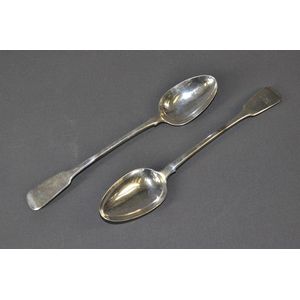George III Sterling Silver Tea Spoons, Hanovarian Pattern
You must be a subscriber, and be logged in to view price and dealer details.
Subscribe Now to view actual auction price for this item
When you subscribe, you have the option of setting the currency in which to display prices to $Au, $US, $NZ or Stg.
- Sterling Silver - Sterling silver is a mixture of 92.5% pure silver and 7.5% of another metal, usually copper. Fine silver is 99.9% pure silver, and is relatively soft and the addition of the very small amount of copper gives the metal enough strength and hardness to be worked into jewellery, decorative and household objects.
- George Iii - George III (1738 - 1820) was King of Great Britain and Ireland from 1760 to 1820.
- Hallmarks - A mark stamped on articles of precious metals in Britain, since the 14th century, certifying their purity. It derives its name from the Guild Hall of the Goldsmiths' Company, who recieved its Charter in 1327 giving it the power to assay (test the purity) and mark articles of gold and silver.
The hallmark will consist of several marks, including the:
- silver standard mark, indicating the purity of the metal. Sterling silver is .925 pure silver.
- the city mark indicating the city in which it was assayed eg London, Birmingham, York etc.
- the date mark, usually a letter of the alphabet in a particular font and case,
- a duty mark, indicating whether duty had been paid to the crown, and only in use from 1784 to 1890
The piece may include an additional mark, the maker's mark, although not forming part of the hallmark, will be located in the vicinity of the hallmarks.
Sometimes silver plated items will bear faux hallmarks, often confusing those not familiar with silver markings. - Hanoverian Pattern - This style was popular under George I, between 1700 and about 1770, and was characterised a simple form consisting of a long bowl and central spine running up the face of the spoon, with the handle widening towards the top, and the end of the spoon curving upwards instead of downwards as with most patterns.
Production of spoons and forks in the Hanoverian style was revived in the 19th century.
This item has been included into following indexes:
Visually similar items

Pair of George III sterling silver table spoons hallmarked, London, 1773, William fern, in Hanoverian pattern, incised initial H over W E, total weight 118gm (2)

Pair Georgian hallmarked sterling silver dessert spoons. London 1778. ( some marks rubbed). Monogrammed. Length 19 cm each. Total weight 76g

Pair of Edwardian sterling silver basting spoons, hallmarked Sheffield, 1908 and 1909, R.M//E.H (Martin hall & Co), on tapering form, monograms to underside, total weight 384gm, length 31.5m

Two various Georgian hallmarked sterling silver serving spoons. London 1816 & 1822; makers for both Wm Eley & Wm Fearn. Length 31 cm. (average) cm. Width 278g
